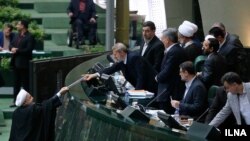President Rouhani announced a draft budget for the coming Iranian year (starting next March 21) of 3,681 trillion rials ($103.9 billion at the official exchange rate), excluding the spending of state enterprises.
That is up about 6 percent from the budget plan for the current year, but since inflation is running at nearly 10 percent, the budget in fact extends the conservative fiscal policy which Rouhani introduced after taking office in 2013.
The draft shows a significant cut in allocations for infrastructure projects by $3.1 billion, a 16 percent reduction. According to ISNA, Mohammad Bagher Nourbakht, the head of the Organization for budget and planning had previously announced that the government would allocate $31 billion for expanding the infrastructure, almost double the amount that is provided in the new draft.
Some experts have criticized the move by Rouhani’s government and say that underfunding infrastructure projects will lead to economic stagnation.
The new budget bill also includes a massive cut in allocations for cash subsidies by $5.3 billion. Tasnim News Agency says that probably cash subsidies for 30 million Iranians will be cut.
If approved by parliament, the combined reductions will be more than $8 billion, a significant chunk of the government budget.
As part of Targeted Subsidies Plan Law, currently around 77 million Iranians (more than 96% of the population) receives $13 cash handout every month. The populist government of Mahmud Ahmadinejad launched the plan in 2010 in an attempt to wean the country off more generous food and fuel subsidies and reduce government spending.
Rouhani is under pressure to boost economic growth and create jobs as his hardline opponents, who were against the nuclear agreement, say he has failed to improve living standards as much as hoped after the lifting of sanctions.
Even though the cash to each individual is not significant, but it is crucial for many low-income families. For a long time, the Rouhani government has been considering cutting the handout for individuals who are not considered needy. But it has hesitated mainly because the move would upset many voters.
However, in a speech broadcast live on state television, Rouhani described the budget as one that would work toward full employment, eliminating poverty and creating social justice.
Rouhani also promised to expand welfare benefits. He said his government will define a minimum income for the citizens and will provide support to everyone who earns less than that.
After struggling for years under sanctions, Iran’s economy picked up in 2016 after most restrictions were lifted under a deal with world powers on its nuclear program. Gross domestic product grew 12.5 percent last year, according to the International Monetary Fund.
But that leap in growth was almost entirely due to a surge in the oil sector as nuclear sanctions were lifted and Iran was allowed to increase its oil exports. The rest of the economy, which is more important to the welfare of most Iranians, improved much less. The IMF projects growth of just 3.5 percent this year.
To address its chronic problem of high unemployment the country needs years of 8 percent growth, Radio Farda’s economic analysts Fereydoon Khavand says.
Unemployment, officially put at around 12.5 percent, is a major cause of public concern and Rouhani said in his speech that 840,000 people would enter the job market next year. Both experts and ordinary people believe the real unemployment rate is much higher than what the government says.
Gross domestic product grew 12.5 percent last year...but that was almost entirely due to a surge in the oil sector as nuclear sanctions were lifted... The rest of the economy, which is more important to the welfare of most Iranians, improved much less.
Official figures are based on a formula that considers one hour of work weekly as employment.
Rouhani is under pressure to boost economic growth and create jobs as his hardline opponents, who were against the nuclear agreement, say he has failed to improve living standards as much as hoped after the lifting of sanctions.
After the nuclear sanctions, direct foreign investment in Iran grew, but reached just $3.5 billion - a small amount compared with other third world countries.
U.S. President Donald Trump, who has taken a tough approach toward Iran, has said Tehran’s missile program should be curbed and wants to punish Iran over its intervention in Yemen and Syria.
Trump has also dealt a blow to the nuclear deal by de-certifying Iran’s compliance, and the U.S. Congress may re-impose sanctions or impose new sanctions. This threat has deterred many foreign banks and companies from doing business with Iran.
As in past years, the draft budget shows spending and revenues in balance, although the actual result will depend on fluctuations in oil prices. Next year’s budget assumes oil prices of about $55 per barrel, Iranian news agencies reported, up from about $50 for the current year’s budget.
The total draft budget, including state enterprises, amounts to 11,949 trillion rials (around $339billion), according to the text of the proposed plan published by Iranian news agencies.
The draft budget has to be passed by parliament and approved by a clerical body that vets bills before they becomes law.



